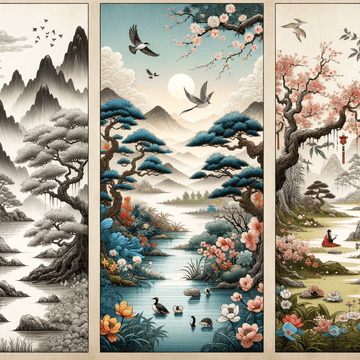Unveiling the Connection Between Nature and Traditional Asian Art Styles: Insights from Chinese, Japanese, and Korean Art
Jun 01, 2024

Exploring the Influence of Nature in Traditional Asian Art Styles
Nature's essence pulsates through the art of many traditional Asian art styles. From the majestic Chinese landscapes to delicate Japanese floral patterns, there's an undeniable spirit weaved into each stroke, embodying an intimate conversation between the artist and the nature.
The Role of Nature in Asian Art
Nature has been a central theme in Asian art throughout history. The infusion of elements like birds, plants, mountains, rivers, and skies transposes a part of the physical world into the artist's canvas, inviting contemplation on the beauty and transience of life. This reiteration of nature in art illustrates the Asian philosophy of living harmoniously with the environment.
Nature in Chinese Art
One of the most revered art forms in China, Shan Shui, literally translates to "Mountain Water." It depicts shiny cascades, towering peaks, and serene valleys with tranquility and harmony as their underlying themes. Similarly, Chinese bird-and-flower paintings use symbols from nature to express human emotions and desires, bringing forth a sense of compassion, perseverance, and spirituality that resonates with Chinese sociocultural values.
Nature in Japanese Art
The Japanese aesthetic of aware - poignant awareness of the ephemerality, highlights nature-inspired imageries representing the fleeting beauty of every season. Kacho-Fugetsu, the tradition of bird-and-flower painting shines a spotlight on natural cycles, while Ukiyo-e woodblock prints highlight the scenic beauty of desolate landscapes and flowering trees, invoking an otherworldly tranquility.
Nature in Korean Art
Simplicity and purity imbued in Korean art styles manifest the desire for spiritual liberation. Joseon Dynasty Paintings, for instance, used nature for abstract, philosophical representation. The paintings hinted at the Korean ethos of balance and harmony, depicting trees representing life's endurance, or rocks symbolizing permanence.
In conclusion, nature forms a powerful vocabulary in traditional Asian art styles, depicting cultural values and philosophical doctrines –– a relationship of man and his surroundings infused with profound meanings.
Interested in exploring more art like what we've discussed today? Our collection offers a diverse range of styles, including Joseon Dynasty Paintings (Korean)and beyond. Feel free to dive into our world of artistic wonders by visiting https://metalposterart.com/collections/joseon-dynasty-paintings-korean. Whether you're looking to admire or to acquire, there's always something captivating waiting for you. We're excited to share our passion for art with you.




